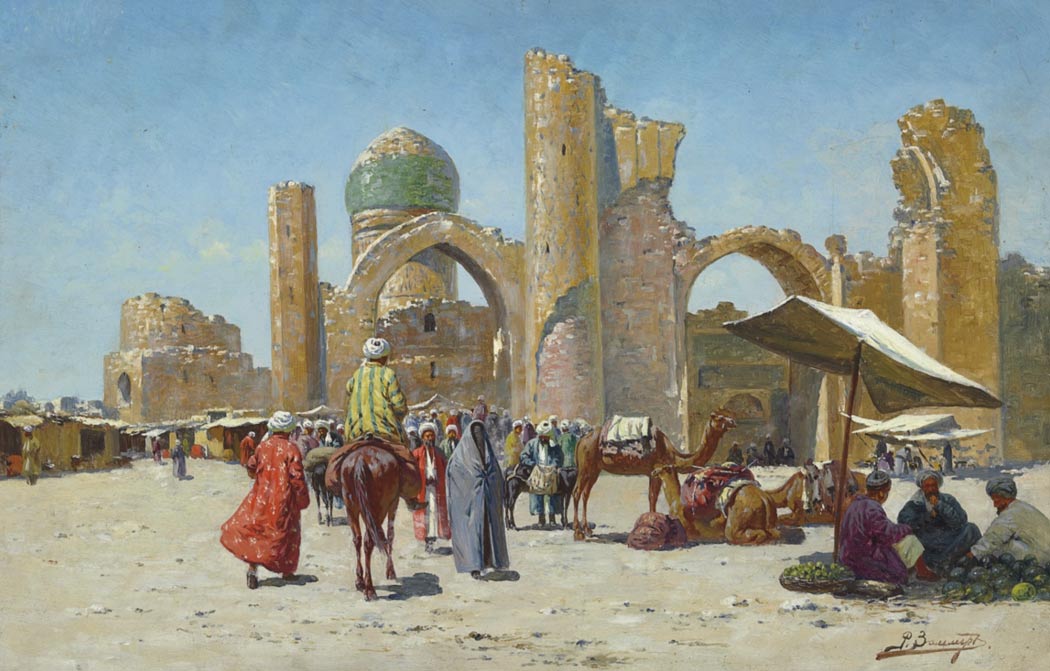Samarkand: An Ancient Link Between East and West
Samarkand, also spelled as Samarqand, is a city located in modern day Uzbekistan, or the historical Central Asian region of Transoxiana. The city’s location in the Zerafshan River Valley provided it with an abundance of natural resources. Additionally, Samarkand was situated along the ancient Silk Road that connected the Mediterranean world and the East. This second factor contributed greatly to Samarkand’s growth, and it became one of the greatest cities in Central Asia. Yet, Samarkand’s history predates this lucrative trade route, and it is one of the oldest continually inhabited city in the Central Asian region.
Ancient Samarkand
Archaeological evidence suggests that the area of Samarkand had already been occupied by human beings during the 14th century BC. During the 6th century BC, the city became part of the Achaemenid Empire when it was conquered by Cyrus the Great. During the reign of Darius the Great, Samarkand was designated as the capital of the satrapy of Sogdiana.
The name Samarkand has its origins in the Sogdian language, and means ‘Stone Fort’. Additionally, archaeological excavations have unearthed the remains of an ancient Sogdian temple. Apart from these, little is known about Samarkand during this period of time. Nevertheless, it has been speculated that it was occasionally visited by travelers from Babylonia, Assyria, and Persia who were on their way to China.

Sogdian merchants making donations to Buddha. 9th century fresco from the Bezeklik Thousand Buddha Caves near Turfan, Xinjiang, China. (Public Domain)
- Experts restore 1,400-year-old shoes from a Chinese tomb
- The despairing cry of the tomb of Alexander the Great from the desert at Siwa Oasis
- Ten Stunning Yet Little Known Ancient Treasures Across Africa
Samarkand Conquered by Alexander the Great
During the 4th century BC, Samarkand was conquered by Alexander the Great during his campaign against the Achaemenid Empire. In the Greek sources, Samarkand was referred to as Maracanda. This city became Alexander’s base for further military expeditions in the region. Samarkand also provides the setting for one of the most notorious episodes in Alexander’s life. According to the ancient sources on Alexander’s life, it was here that the Macedonian ruler killed Cleitus, an officer of the Macedonian army who once saved the king at the Battle of Granicus, during a drunken quarrel.

The killing of Cleitus, André Castaigne 1898–1899 (Public Domain)
Following the death of Alexander, Samarkand became part of the Seleucid Empire’s satrapy of Bactria. Around the second half of the 3rd century BC, the Seleucids were occupied with their war with the Ptolemies in the West.
The satrapy of Bactria seized this opportunity to gain independence, and formed the Graeco-Bactrian kingdom. Thus, Samarkand was incorporated into this new entity. The fall of the Graeco-Bactrian kingdom to the Kushans saw the ownership of Samarkand switching hands once again.
After the Kushan Period
Samarkand was in a decline during the Kushan period, and only experienced a revival many centuries later. During the 7th century AD, the Silk Road was reopened by China’s Tang Dynasty. This brought great wealth to the city, and Samarkand prospered from the trade that passed through its gates. Aristocratic residences dating to between the 6th and 8th centuries AD have been excavated at Samarkand, and attest to the city’s wealth during that period of time.

Triumph by Vasily Vereshchagin, depicting the Sher-Dor Madrasah in the Registan. (Public Domain)
Other Conquerors of Samarkand
Samarkand would be conquered by the Turks, and then the Arabs around the beginning of the 8th century AD. Following the conquest by the latter, Islam became the dominant religion amongst the city’s population.
In 1220 AD, Samarkand suffered a terrible blow when it was conquered by the Mongols under Genghis Khan. It is claimed that only a quarter, or even less, of its former population was left following the Mongol devastation. Moreover, it is said that many skilled craftsmen were deported from the city to Mongolia.

Building the Great Mosque of Samarkand. Illustration by Bihzad for the Zafar-Nameh. Text copied in Herat in 1467-68 and illuminated c. the late 1480s. (CC BY-SA 4.0)
Samarkand’s survival only came about in 1371, when another ruthless conqueror, Timur the Lame, known also as Tamerlane, decided to make Samarkand his capital. Thus, the city was immediately fortified with a new wall, and a citadel was built. Moreover, craftsmen were deported by Tamerlane from his conquered territories to Samarkand, where they built new buildings.
Some of the most well-known buildings constructed in Samarkand during the Timurid period include the Bibi-Khanum Mosque, the Registan Mosque, the Gur-i Amir (the ‘Tomb of the Ruler’, which is Tamerlane’s mausoleum), and Ulugh Beg’s Observatory.
- Meet Father Frost and his Fairy Goddaughter Snow Maiden: Magical Characters of Winter from Russia
- The Snow Maiden of Slavic Folklore: Magical Characters of Winter from Russia

Ulugh Beg Madrasah (CC BY-SA 3.0)
Many scholars claim that the Timurid period was the peak of Samarkand’s history. After the fall of the Timurids at the beginning of the 16th century AD, Samarkand was conquered by Uzbek nomads. The new dynasty, the Shaybanids, moved the capital from Samarkand to Bukhara. Nevertheless, the city continued to be embellished by its new masters. In 1660, for instance, three madrasas were built on the Registan square, thus giving it its final form. Nevertheless, the city’s days of glory were already behind it.
Featured image: A view of the Bibi-Khanum Mosque, Samarkand. Photo source: Public Domain.
By Ḏḥwty
References
Forbes, A., 2012. Timur's Legacy. [Online]
Available at: http://www.cpamedia.com/article.php?pg=archive&acid=120613150427&aiid=120613151433
Grenet, F., 2002. Samarqand i. History and Archeology. [Online]
Available at: http://www.iranicaonline.org/articles/samarqand-i
Lendering, J., 2015. Maracanda. [Online]
Available at: http://www.livius.org/articles/place/maracanda/
UNESCO, 2016. Samarkand – Crossroad of Cultures. [Online]
Available at: http://whc.unesco.org/en/list/603
UzLand, Inc, 1998. Samarkand- The Gem of The East. [Online]
Available at: http://www.tashkent.org/uzland/samarkand.html
Waugh, D. C., 2001. Samarkand. [Online]
Available at: http://depts.washington.edu/silkroad/cities/uz/samarkand/samarkand.html



















